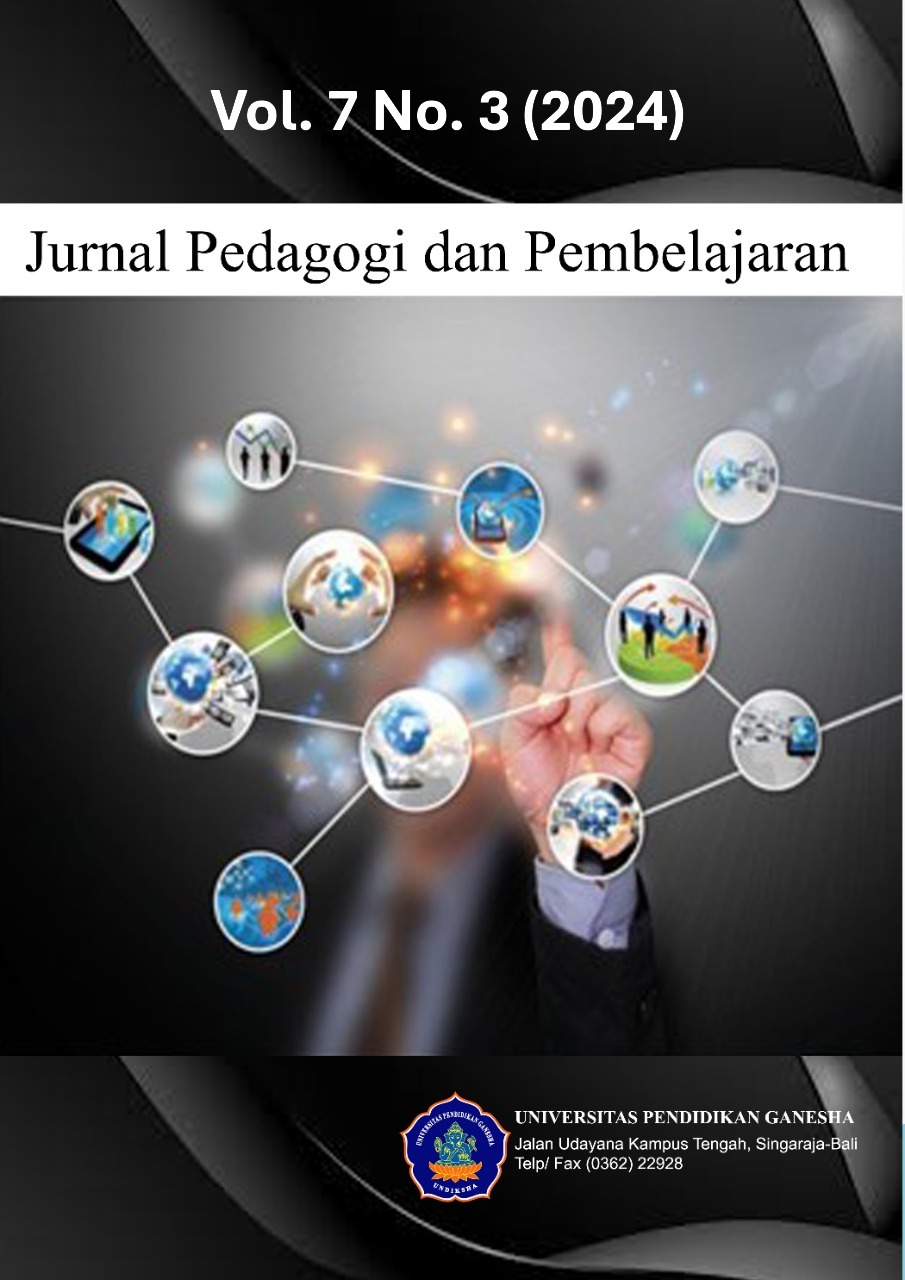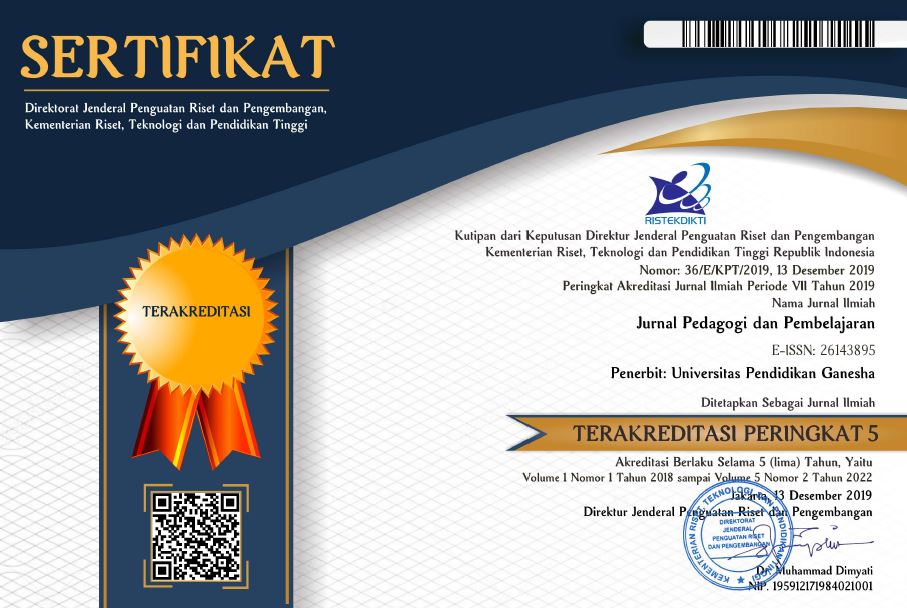Interactive Electronic Learning Materials in Civic Education: A Technology-Based Approach with Flip PDF Professional
DOI:
https://doi.org/10.23887/jp2.v7i3.90658Keywords:
Electronic Teaching Materials, Flip PDF Professional, PPKnAbstract
The development of interactive electronic teaching materials in Civic Education (PPKn) using Flip PDF Professional aims to enhance student engagement and optimize the use of technology in elementary classrooms. This study seeks to develop electronic teaching materials that are valid, practical, and effective in improving students' learning outcomes. The research method used is Research and Development (R&D) with the Four-D Model (Define, Design, Develop, Disseminate). Data collection instruments include validation sheets from subject matter experts, media experts, and language experts; practicality sheets from teachers and students; and effectiveness tests through pre-test and post-test assessments. The validation results indicate that the developed teaching materials are highly valid, with 95% from subject matter experts, 85% from media experts, and 91% from language experts. The practicality of the teaching materials is rated as very high, with 98.33% from teachers and 93.5% from students. The effectiveness test using the N-Gain score shows an average of 0.4455, categorized as moderate improvement, with the pre-test average score of 60.53 increasing to 78.78 in the post-test. These findings demonstrate that the interactive electronic teaching materials developed using Flip PDF Professional are valid, highly practical, and moderately effective for use in Civic Education learning at the elementary school level. Therefore, this teaching material can serve as an innovative solution for teachers to optimize technology-based learning in classrooms.
References
Ainsyiyah, E. D., & Ginting, A. M. (2020). Pancasila and Civic Education Learning by Non Pancasila and Civic Education Program Graduate. Budapest International Research and Critics Institute-Journal (BIRCI-Journal), 3(3), 1650–1659. https://doi.org/10.33258/birci.v3i3.1097. DOI: https://doi.org/10.33258/birci.v3i3.1097
Akhmad, R., Sugandi, D., Nandi, N., & Rahmawati, R. (2018). Infographic Design as Visualization of Geography Learning Media. IOP Conference Series: Earth and Environmental Science, 145(1). https://doi.org/10.1088/1755-1315/145/1/012011. DOI: https://doi.org/10.1088/1755-1315/145/1/012011
Alkhasawnh, S., & Alqahtani, M. A. M. (2019). Fostering students’ self-regulated learning through using a learning management system to enhance academic outcomes at the University of Bisha. TEM Journal, 8(2). https://doi.org/10.18421/TEM82-47. DOI: https://doi.org/10.18421/TEM82-47
Amanda, C., Sugiarti, & H. M. Lubis, P. (2022). Pengembangan LKPD berbasis Discovery Learning Berbantuan Software Tracker untuk Meningkatkan Pemahaman Konsep Peserta Didik Kelas X di SMAN 2 Babat Supat. Jurnal Literasi Pendidikan Fisika (JLPF), 3(1), 58–66.
https://doi.org/10.30872/jlpf.v3i1.970. DOI: https://doi.org/10.30872/jlpf.v3i1.970
Aprilliyah. (2014). Pengembangan Media Pembelajaran Modul Interaktif Pada Materi Jurnal Khusus Kelas X Akuntansi di SMK Negeri Mojoagung. Jurnal Khusus, 2(2), 1–7.
https://jurnalmahasiswa.unesa.ac.id/index.php/35/article/view/9412.
Bojko, A. (2013). Eye Tracking The User Experience. Rosenfeld Media.
Cohen, J., Wong, V., Krishnamachari, A., & Berlin, R. (2020). Teacher coaching in a simulated environment. Educational Evaluation and Policy Analysis, 42(2), 208–231.
https://doi.org/10.3102/0162373720906217. DOI: https://doi.org/10.3102/0162373720906217
Dewantara, J. A., Suhendar, I. F., Rosyid, R., & Atmaja, T. S. (2019). Pancasila as Ideology and Characteristics Civic Education in Indonesia. International Journal for Educational and Vocational Studies, 1(5), 400–405. https://doi.org/10.29103/ijevs.v1i5.1617. DOI: https://doi.org/10.29103/ijevs.v1i5.1617
Dirgantari, N., & Cahyani, I. (2023). A Concept: Ethnopedagogical-Based Character Educational Model of Elementary School Students. Journal Research of Social Science, Economics, and Management, 2(9), 2096–2108. https://doi.org/10.59141/jrssem.v2i09.420. DOI: https://doi.org/10.59141/jrssem.v2i09.420
Fahmi, S., Priwantoro, S. W., Cahdriyana, R. A., Hendroanto, A., Rohmah, S. N., & Nisa, L. C. (2019). Interactive Learning Media Using Kvisoft Flipbook Maker for Mathematics Learning. Journal of Physics: Conference Series, 1188(1). https://doi.org/10.1088/1742-6596/1188/1/012075. DOI: https://doi.org/10.1088/1742-6596/1188/1/012075
Faris Yudiana Putra, M., & Rezania, V. (2023). Pengembangan Lembar Kerja Peserta Didik (LKPD) Berbasis Pendekatan Saintifik Dalam Muatan Materi IPAS Kelas IV. Pendas : Jurnal Ilmiah Pendidikan Dasar, 8(1), 4636–4652. https://doi.org/10.23969/jp.v8i1.8146. DOI: https://doi.org/10.23969/jp.v8i1.8146
Gupta, T., Burke, K. A., & Greenbowe, T. J. (2022). Shifting the ownership of learning from instructor to students through student-led instructor-facilitated guided-inquiry learning. In Teaching Innovation in University Education: Case Studies and Main Practices, 69–98. https://doi.org/10.4018/978-1-6684-4441-2.ch005. DOI: https://doi.org/10.4018/978-1-6684-4441-2.ch005
Hong, Q. N., Pluye, P., Fàbregues, S., Bartlett, G., Boardman, F., Cargo, M., Dagenais, P., Gagnon, M. P., Griffiths, F., Nicolau, B., O’Cathain, A., Rousseau, M. C., & Vedel, I. (2019). Improving the content validity of the mixed methods appraisal tool: a modified e-Delphi study. Journal of Clinical Epidemiology, 111, 49-59.e1. https://doi.org/10.1016/j.jclinepi.2019.03.008. DOI: https://doi.org/10.1016/j.jclinepi.2019.03.008
Jonsson, A., & Panadero, E. (2016). The Use and Design of Rubrics to Support AfL. In C. C. & R. G. D. Carless, S. Bridges (Ed.), Scaling up Assessment for Learning in Higher Education (pp. 99–111). Series Editor, Claire Wyatt-Smith. https://doi.org/10.1007/978-981-10-3045-1. DOI: https://doi.org/10.1007/978-981-10-3045-1_7
Karakaita Putri, P. N. A., Arini, N. W., & Sumantri, M. (2019). Pengaruh Strategi Directed Reading Thinking Activity (DRTA) Berbantuan Media Flip Chart Terhadap Keterampilan Membaca Pemahaman. Jurnal Ilmiah Sekolah Dasar, 3(2), 158. https://doi.org/10.23887/jisd.v3i2.17762. DOI: https://doi.org/10.23887/jisd.v3i2.17762
Kurnianto, D. (2022). Development of Mathematics E-Modules Through the Professional Flip PDF Application Assisted React Strategy to Improve Problem Solving Ability of Vocational Middle School Students Concentration of Accounting Expertise’. International Journal of Science and Society, 4(3), 499–512. https://doi.org/10.54783/ijsoc.v4i3.544. DOI: https://doi.org/10.54783/ijsoc.v4i3.544
Kurniawan, M. I. (2013). Integrasi Pendidikan Karakter Ke Dalam Pembelajaran Kewarganegaraan Di Sekolah Dasar. Jurnal Pemikiran Dan Pengembangan Sekolah Dasar (JP2SD).
https://doi.org/10.22219/jp2sd.v1i1.1528. DOI: https://doi.org/10.22219/jp2sd.v1i1.1528
Lestari, E., Nulhakim, L., & Suryani, D., W. (2022). Pengembangan E-modul Berbasis Flip Pdf Professional“Tema Global Warming Sebagai Sumber Belajar Mandiri Siswa Kelas VII.” Journal of Science Education, 6(2). https://doi.org/10.33369/pendipa.6.2.338-345. DOI: https://doi.org/10.33369/pendipa.6.2.338-345
Lyon, A. R., Coifman, J., Cook, H., McRee, E., Liu, F. F., Ludwig, K., & McCauley, E. (2021). The Cognitive Walkthrough for Implementation Strategies (CWIS): a pragmatic method for assessing implementation strategy usability. Implementation Science Communications, 2(1), 1–16. https://doi.org/10.1186/s43058-021-00183-0. DOI: https://doi.org/10.1186/s43058-021-00183-0
Malik, R. S. (2018). Educational Challenges in 21st Century and Sutainable Development. Journal of Sustainable Development Education and Research, 2(1), 9–20.
https://doi.org/10.17509/jsder.v2i1.12266. DOI: https://doi.org/10.17509/jsder.v2i1.12266
Marlani, L., & Prawiyogi, A. G. (2019). Penerapan Model Pembelajaran Project Based Learning Untuk Meningkatkan Keterampilan Menulis Puisi Di Sekolah Dasar. Al-Aulad: Journal of Islamic Primary Education, 2(1). https://doi.org/10.15575/al-aulad.v2i1.4427. DOI: https://doi.org/10.15575/al-aulad.v2i1.4427
Mubar, M. K. N. A. (2015). Developing English Learning Materials For Young Learners Based On Needs Analysis At Mtsn Model Makassar. ETERNAL (English, Teaching, Learning, and Research Journal), I(02), 257–269. https://doi.org/10.24252/Eternal.V12.2015.A8. DOI: https://doi.org/10.24252/Eternal.V12.2015.A8
Mufarola, K., & Murbowo, A. R. (2019). Manfaat Pembelajaran Robotika Untuk Belajar Siswa. Prosiding Seminar Nasional Pendidikan Program Pascasarjana Universitas Pgri Palembang 12 Januari 2019, 407–417. https://jurnal.univpgri-palembang.ac.id/index.php/Prosidingpps/article/view/2552.
Munawaroh, F., & Prasetyaningtyas, F. D. F. D. A. (2023). Upaya Peningkatan Hasil Belajar Siswa Melalui Model Pembelajaran Cooperative Learning Tipe Team Game Tournament (Tgt) Pada Mata Pelajaran Matematika Kelas V Sd Negeri Ngaliyan 03. Jurnal Ilmu Pendidikan, 1(2), 314–341. http://ejournal.pdtii.org/index.php/ngaos/article/view/7.
Nisa, A. H., Mujib, M., & Putra, R. W. Y. (2020). Efektivitas E-Modul dengan Flip Pdf Professional Berbasis Gamifikasi Terhadap Siswa SMP. Jurnal Pendidikan Matematika Raflesia, 05(02). https://doi.org/https://doi.org/10.33369/jpmr.v5i2.11406.
Nurbaiti, C., Kurniadewi, F., & Nurjayadi, M. (2021). The development of electronic module (E-MODULE) carbohydrates using the professional FLIP PDF application in organic chemistry course. In AIP Conference Proceedings, 040025. https://doi.org/10.1063/5.0041893. DOI: https://doi.org/10.1063/5.0041893
Nurchotimah, A. S. I., Utomo, A. D. N., Khasanah, D. R. A. U., & Nurgiansah, T. H. (2022). Development of Electronic Books (E-Books) for Supervision of Public Services to Increase Knowledge of PPKn Teachers. JED (Jurnal Etika Demokrasi), 7(3), 513–519. https://doi.org/10.26618/jed.v7i3.7656. DOI: https://doi.org/10.26618/jed.v7i3.7656
Nurhayati, N., & Rahardi, R. (2021). Kemampuan Berpikir Kreatif Mahasiswa Dalam Mengembangkan Media Pembelajaran Matematika Saat Pandemi Covid-19. Pembelajaran Matematika Inovatif, 4(2), 331–342. https://doi.org/10.22460/jpmi.v4i2.331-342.
Nurjayadi, M., Sadono, R., & Afrizal. (2021). Development of e-module structure and protein function with flip PDF professional application through online learning. In AIP Conference Proceedings, 040029. https://doi.org/10.1063/5.0041891. DOI: https://doi.org/10.1063/5.0041891
Octavia, E., & Rube’i, M. A. (2017). Penguatan pendidikan karakter berbasis Pancasila untuk membentuk mahasiswa prodi PPKN menjadi warga negara yang baik dan cerdas [The strengthening of character education based on Pancasila to form a student of PPKn major to be a good and intelligent citiz. Social Horizon: Journal of Social Education/ Sosial Horison: Jurnal Pendidikan Sosial, 4(1), 111–124. https://doi.org/https://journal.ikippgriptk.ac.id/index.php/sosial/article/download/427/409
Putri, M. Z. D., & Dafit, F. (2021). Pengembangan Media Pembelajaran Video Animasi Pada Tema 9 Subtema 2 Siswa Kelas V Sdit Al Madinah Dumai. Jurnal Tunas Bangsa, 8(2), 180–192.
https://doi.org/10.46244/tunasbangsa.v8i2.1647. DOI: https://doi.org/10.46244/tunasbangsa.v8i2.1647
Rahayu, Y. S., Mujiyanto, J., Suwandi, S., & Fitriati, S. W. (2023). The Impact of Electronic Storybook and Print Picture Book on the Reading Comprehension of Undergraduates with Varying Levels of Critical Thinking. Migration Letters, 20, 224–237.
https://jurnal.stkipahsingaraja.ac.id/index.php/tatefl/article/view/665.
Rahimi, M., & Yadollahi, S. (2017). Effects of offline vs. online digital storytelling on the development of EFL learners’ literacy skills. Cogent Education, 4(1). https://doi.org/10.1080/2331186X.2017.1285531. DOI: https://doi.org/10.1080/2331186X.2017.1285531
Retnasari, L., Hidayah, Y., & Prasetyo, D. (2021). Reinforcement of Character Education Based on School Culture to Enhancing Elementary School Students’ Citizenship Character. Jurnal Ilmiah Sekolah Dasar, 5(2), 351. https://doi.org/10.23887/jisd.v5i2.38072. DOI: https://doi.org/10.23887/jisd.v5i2.38072
Rutta, C. B., Schiavo, G., Zancanaro, M., & Rubegni, E. (2021). Comic-based Digital Storytelling for Content and Language Integrated Learning. Educational Media International, 58(1), 21–36.
https://doi.org/10.1080/09523987.2021.1908499. DOI: https://doi.org/10.1080/09523987.2021.1908499
Sakman, Abdulkarim, A., Komalasari, K., & Masyitoh, I. S. (2024). Unveiling the Merdeka Curriculum: A Review of Local Wisdom Integration in Civic Education for Junior High Schools. KnE Social Sciences, 2024, 200–208. https://doi.org/10.18502/kss.v9i19.16496. DOI: https://doi.org/10.18502/kss.v9i19.16496
Sukerti, G. N. A., & Susana, K. Y. (2019). Fostering Students’ Presentation Skill Using Infographic: the Implementation of Project-Based Learning in English for Specific Purposes. International Journal of Indonesian Education and Teaching, 3(2), 227–239. https://doi.org/10.24071/ijiet.v3i2.1940. DOI: https://doi.org/10.24071/ijiet.v3i2.1940
Suniyasih, N. M., Ratminingsih, N. M., & Budasi, I. G. (2020). Development of Multilingual Thematic Picture Dictionary: A Support for Literacy. Jurnal Pendidikan Dan Pengajaran, 53(3), 236.
https://doi.org/10.23887/jpp.v53i3.27508. DOI: https://doi.org/10.23887/jpp.v53i3.27508
Torbat, S., & Zarei, I. (2018). Test and validity of emotional intelligence model with social adjustment in students. Iranian Journal of Positive Psychology, 4(2), 52–60.
https://www.researchgate.net/profile/World-Of-Researches-Publication-W-R-P/publication/365730484.
Uygarer, R., & Uzunboylu, H. (2017). An investigation of the digital teaching book compared to traditional books in distance education of teacher education programs. Eurasia Journal of Mathematics, Science and Technology Education, 13(8), 5365–5377. https://doi.org/10.12973/eurasia.2017.00830a. DOI: https://doi.org/10.12973/eurasia.2017.00830a
Wu, X. ., He, Z. ., Li, M. ., Han, Z. ., & Huang, C. (2022). Identifying Learners’ Interaction Patterns in an Online Learning Community. Int. J. Environ. Res. Public Health, 19, 2245. https://doi.org/10.3390/ ijerph19042245. DOI: https://doi.org/10.3390/ijerph19042245
Yulkifli, Y., Jaafar, R., & Resnita, L. (2020). Developing Student Worksheets Using Inquiry-based Learning Model with Scientific Approach to Improve Tenth Grade Students’ Physics Competence. Jurnal Penelitian Fisika Dan Aplikasinya (JPFA), 10(1). https://doi.org/10.26740/jpfa.v10n1.p56-70. DOI: https://doi.org/10.26740/jpfa.v10n1.p56-70
Downloads
Published
How to Cite
Issue
Section
License
Copyright (c) 2024 Fadlizon Julian, Yalvema Miaz

This work is licensed under a Creative Commons Attribution-ShareAlike 4.0 International License.
Authors who publish with Jurnal Pedagogi dan Pembelajaran agree to the following terms:
- Authors retain copyright and grant the journal the right of first publication with the work simultaneously licensed under a Attribution-ShareAlike 4.0 International (CC BY-SA 4.0) that allows others to share the work with an acknowledgment of the work's authorship and initial publication in this journal
- Authors are able to enter into separate, additional contractual arrangements for the non-exclusive distribution of the journal's published version of the work (e.g., post it to an institutional repository or publish it in a book), with an acknowledgment of its initial publication in this journal.
- Authors are permitted and encouraged to post their work online (e.g., in institutional repositories or on their website) prior to and during the submission process, as it can lead to productive exchanges, as well as earlier and greater citation of published work. (See The Effect of Open Access)











